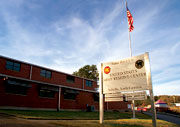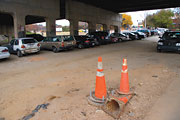It’s no news that Asheville is getting more crowded, so it’s a given that such perennially thorny issues as rezoning and large-scale development will be conspicuous at Council meetings. Throw in environmental and energy concerns, and you’re sure to make the current City Council sit up and pay attention.
Meanwhile, recent events have demonstrated that political pressure can change Council members’ minds — at least in the case of the Army Reserve.
Rethinking the rent

Rent control: Council scaled back an earlier rent hike for the Army Reserve Center that proved controversial and prompted protests from the Asheville Tribune and a barrage of angry e-mails to Mayor Terry Bellamy. photo by Jonathan Welch
|
An Oct. 10 decision to raise the rent on the Army Reserve Center in West Asheville caused enough of a stink that Council decided to revisit the issue at its Nov. 28 formal session. Since 2000, Asheville has charged the federal government $60,000 a year to rent the Louisiana Avenue facility. In October, Council voted 6-1 to raise the annual rent to $112,000 through 2009, over the objections of Council member Carl Mumpower. The decision drew considerable flak from the conservative Asheville Tribune and a flurry of nasty e-mails to Mayor Terry Bellamy (see “Unfriendly Fire,” Nov. 1 Xpress).
At Mumpower’s request, the issue reappeared on the Nov. 28 consent agenda. Thanking the mayor for giving the matter a second look, Mumpower hashed out the Reserve Center’s history, noting that the total rent charged during the facility’s first 50 years amounted to $1 (a whopping 2 cents per annum).
“It is obvious that there were considerations other than money,” said Mumpower.
City staff recommended a $60,000 base rent, adjusted to reflect the Consumer Price Index.
Mumpower applauded the compromise, declaring, “This is a recognition of just who these folks are whose pockets we are reaching into.”
During the public-comment period earlier in the meeting, Walter Plaue, a regular at Council sessions, had taken umbrage at Council members’ initially handling of the rent increase.
Conceding that “the city is certainly in its rights to charge what the traffic will bear,” Plaue went on to ask: “What message is the city sending? What is the right thing to do from a macro standpoint? [The issue is] symbolic of your attitude toward our servicepeople.”
And although Council member Brownie Newman eventually fell in with his colleagues, he also urged them not to lose sight of another aspect of the situation. “Think about what’s fair to the owners of these facilities — that is, the taxpayers,” said Newman.
The amended rent passed unanimously.
Clean and green?
The bulk of the six-and-a-half-hour meeting was taken up by an ambitious development proposal for a tree-dotted, 20.66 acre pasture at the corner of Hendersonville Road and Racquet Club Road in south Asheville. The developer’s request for substantially higher-density zoning sparked resistance from homeowners in the adjoining Crowfields Condominiums, a low-density community that’s home to many retirees. Before the meeting even started, the Council chamber and two overflow rooms served by closed-caption television were filled with spectators.
The project, proposed by Sizemore Developers LLC, will include 16 buildings and 336 residential condos. Four commercial buildings would be built later by businesses leasing the lots from the developer.
But what got Council members’ attention was a list of eco-minded features proposed by the developer: “green” building standards, storm-water controls and pedestrian-friendly design.
“This is probably the highest-quality project I have seen in my one year on Council,” proclaimed Council member Bryan Freeborn. “Without even asking, this developer came to us with all of the wish lists we could possibly come up with.”
The buildings will conform to LEED standards (Leadership in Energy and Environmental Design, a rating system developed by the U.S. Green Building Council).
Council member Robin Cape seemed equally impressed, noting, “We are facing a time of unprecedented environmental stress.”
Attorney Lou Bissette, representing the developer, praised the project for its innovation. “This can be the model for Asheville’s smart-growth policies,” said the former Asheville mayor. “We believe this can be a win/win situation.” Bissette was one of a parade of professionals rolled out by the developer to describe in detail the development’s environmentally sensitive features.
But some Crowfields residents were unhappy about the project’s high density, maintaining that the developer could build significantly fewer units and still turn a profit.
“The new development, in my opinion, should not exceed the zoning of the surrounding developments,” said Mack Cox, president of the Crowfields Condominium Association.
“This is what we call the zoning game,” observed Bob Malkin, a local landscape architect who took issue with the number of trees that would be removed. “This is [a] Tree City USA,” he noted.
There was also some confusion concerning the buildings’ height, with residents citing a 60-foot figure while the developers were talking 40 feet tall. Eventually, Urban Planner Julie Cogburn resolved the discrepancy, explaining that in planning terms, height is defined as the distance from the main floor to the ceiling of the highest livable level — in this case, 38 feet. But the actual distance from a ground-level garage to the peak of the roof would be closer to 60 feet. Irregular topography added to the confusion, since some structures would be partly underground and others wouldn’t.
In all, about 20 members of the public spoke, and they were nearly evenly split between opponents and supporters of the project. Those in favor touted both the environmental amenities and the planned improvements along the busy Racquet Club Road (which provides access to the Asheville Racquet Club).
According to the site plan, several “rain gardens” will collect storm runoff, using the soil and vegetation to help filter pollutants from the water. Crowfields has had problems with runoff in the past, and the city has recently created a storm-water utility to address such concerns.
“We know of no other development in Asheville that has conformed to such a stringent level of storm-water control,” said landscape architect Clay Mooney.
Mumpower, however, took a dim view of tinkering with the city’s zoning designations.
“Why do we have zoning if we are willing to make drastic leaps?” he asked. “We are going to have high density or we are going to protect neighborhoods. We cannot do both at the same time.”
Planning and Development Director Scott Shuford responded that while most of the RM-6 zoning applied along Hendersonville Road in 1997 was intended to keep future development in check, there is always the possibility that density can increase.
“On Hendersonville Road, I don’t think RM-6 [residential, multifamily, six units per acre] means very much,” said Shuford.
With most on Council clearly enthusiastic about the project, the focus shifted toward how to make sure the developers keep their glowing promises.
“What if something goes awry?” wondered Vice Mayor Holly Jones, adding, “We’ve had a little bit of trouble with enforcement issues.”
If the stipulated conditions aren’t met, said Shuford, the city can refuse to issue a certificate of occupancy. A newly budgeted Planning and Development staffer, he added, will conduct on-site inspections to ensure compliance.
In the end, Council members enshrined the promised amenities as conditions for approving the rezoning. They also got assurance that no grading will occur until funding is secured for the project.
The conditional rezoning passed 6-1 with Mumpower dissenting.
Other business

Under the bridge: The city will clean up and redesign the parking area where Lexington Avenue passes beneath I-240.
|
• Asheville will assume ownership of a right of way along Lexington Avenue underneath Interstate 240. Residents have complained about the area’s rundown appearance. By taking over the property, formerly owned by the state Department of Transportation, the city can develop it as an official parking lot with improved access and a bike rack, noted Urban Planner Alan Glines. Mayor Bellamy asked Glines to see if other DOT-owned properties in the city might be suitable for similar treatment. The measure passed 6-0 (Freeborn wasn’t feeling well and left early).
• Council designated the St. Dunstan’s neighborhood (near Biltmore Village) as Asheville’s fourth local historic district, joining Albemarle Park, Montford and Biltmore Village. Any exterior alterations made to property in these districts must conform to their historic character. The discussion focused on homeowners’ inability to make energy-efficient upgrades, but the Historic Resources Commission may revise its guidelines to allow such measures. The change passed 4-2 with Mumpower and Newman opposed.
• Council approved conditional rezoning for a 3.7 acre parcel near Lake Julian. This will enable the Volvo assembly plant off Long Shoals Road to expand the storage space on its campus. The rezoning passed 5-1; Mumpower voted no.



Before you comment
The comments section is here to provide a platform for civil dialogue on the issues we face together as a local community. Xpress is committed to offering this platform for all voices, but when the tone of the discussion gets nasty or strays off topic, we believe many people choose not to participate. Xpress editors are determined to moderate comments to ensure a constructive interchange is maintained. All comments judged not to be in keeping with the spirit of civil discourse will be removed and repeat violators will be banned. See here for our terms of service. Thank you for being part of this effort to promote respectful discussion.